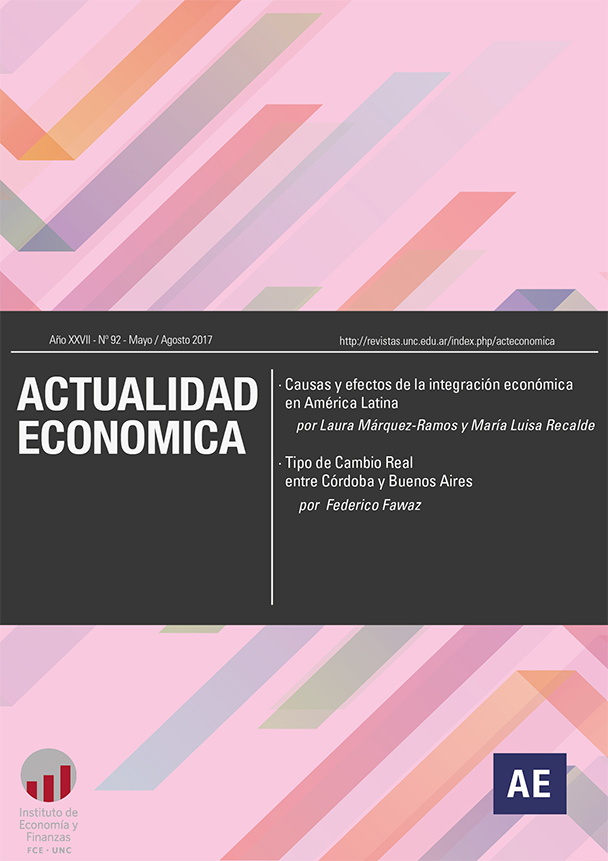Causes and effects of economic integration in Latin America
Keywords:
economic integration, production networks, intermediate goods, institutional quality, extensive margin, intensive margin, determinants, Latin AmericaAbstract
The central issue to be addressed in this article is the measurement of the causes and effects of integration agreements in Latin America. The role of integration of two trade agreements, LAIA and Mercosur, in value chains or production networks, in exports of goods, as well as the degree of depth and institutional quality of these trade agreements are studied. In this analysis, a distinction is made between the intensive margin and the extensive margin of trade. Finally, the factors contributing to creating or strengthening trade agreements in Latin America, by distinguishing between economic, geographic, political and institutional determinants, are analyzed.
Downloads
References
Baier S.y Bergstrand J.(2004). “Economic Determinants of Free Trade Agreements”. Journal of International Economics, 64(1), 29–63.
Baier, S. L. y Bergstrand, J. H. (2007). “Do free trade agreements actually increase members’ international trade?”. Journal of International Economics, 71(1), 72-95.
Bittencourt, G. y Domingo, R. (2004). “Los determinantes de la IED y el efecto del MERCOSUR”. El Trimestre Economico, 73-128.
El País (2016). “Trump se retirará del tratado comercial del Pacífico nada más llegar al Gobierno”. El País Internacional, 22 de Noviembre de 2016.
Florensa, L. M., Márquez-Ramos, L., Recalde, M. L. y Barone, M. V. (2013). “Acuerdos de integración económica en Latinoamérica: Efectos sobre los márgenes de comercio”. Revista de Economía, 20(1), 71.
Florensa, L. M., Márquez-Ramos, L., Recalde, M. L. y Barone, M. V. (2014a). “Does Economic integration increase trade margins? Empirical evidence from LAIAs countries”. Working Paper Universitat Jaume I.
Florensa, L. M., Márquez-Ramos, L. y Recalde, M. L. (2014b). “Revisiting the role of institutional and political factors on economic integration. The case of Latin America”. Artículo presentado en las Jornadas de Economía del Banco Central del Uruguay. Montevideo. Agosto 2014.
Florensa, L. M., Márquez-Ramos, L., Martínez-Zarzoso, I. y Recalde, M. L. (2015a). “Regional versus global production networks: where does Latin America stand?” Applied Economics, 47(37), 3938-3956.
Florensa, L. M., Márquez-Ramos, L. y Recalde, M. L. (2015b). “The effect of economic integration and institutional quality of trade agreements on trade margins: evidence for Latin America”. Review of World Economics, 151(2), 329-351.
Florensa, L. M., Márquez-Ramos, L. Recalde, L. M. y Degiovanni, P. G. (2016). “Determinantes de la Integración Económica en Latinoamérica.” Mimeo.
Gereffi, G. (2015). “América Latina en las cadenas globales de valor y el papel de China”. Boletín Informativo Techint 350.
Kohl, T., Brakman S. and Garretsen, H. (2013).“Do Trade Agreements Stimulate International Trade Differently? Evidence from 296 Trade Agreements,” CESifo Working Paper Series 4243, CESifo Group Munich.
Márquez-Ramos, L., Martínez-Zarzoso, I. y Suárez-Burguet, C. (2011). “Determinants of Deep Integration: Examining Socio-political Factors”. Open Economies Review, 22(3), 479-500.
Márquez-Ramos, L., Florensa, L. M. y Recalde, M. L. (2015). “Economic Integration Effects on Trade Margins: Sectoral Evidence from Latin America”. Journal of Economic Integration, 269-299.
The Economist (2016). “Lexington: Farewell to Asia”. 10 de diciembre de 2016. Disponible en http://www.economist.com/news/united-states/21711328-our-columnist-accompanies-outgoing-defence-secretary-his-final-world-tour-farewell
Downloads
Published
Issue
Section
License
Those authors who have published with this journal, accept the following terms:
Authors will conserve their copyright and guarantee the magazine the right of first publication of their work, which will be simultaneously subject to the Creative Commons Attribution-NonCommercial-NoDerivative 4.0 International License that allows third parties to share the work as long as the author and first publication of this magazine are indicated.
Authors may adopt other non-exclusive license agreements to distribute the published version of the work (e.g., deposit it in an institutional telematic archive or publish it in a monographic volume) provided that the initial publication in this journal is indicated.
Authors are allowed and encouraged to disseminate their work through the Internet (e.g., in institutional telematic archives or on their website) before and during the submission process, which may lead to interesting exchanges and increase citations of the published work. (See The effect of open access)









